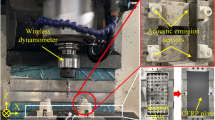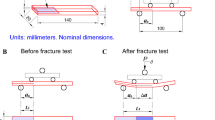Abstract
The development of efficient, high-quality joining techniques is still considered an obstacle to the wide application of composite materials as structural components. Mechanical fastening is one of the most common joining techniques. However, this requires the composite material to be drilled, which introduces significant damage to the material. The improvement of drilling techniques is dependent on the accurate analysis of the induced damage. Moreover, concerning repair activities, the assessment of the machining-induced damage enables the determination of its significance, identifying the immediacy of repair. The delamination factors described in the literature quantify the damage but neither has achieved full acceptance to create international standards, which are yet to be defined. This work proposes a new approach to assess the delamination factor by using an image processing methodology, based on digital radiography, to characterize the drilling-induced damage. This approach reconsiders the assumptions made prior to the application of the delamination factor, by reducing the affected area to a quantified damaged area ratio. The obtained results highlight that the minimization of the quantified damage for the most irregular delamination shapes to a single, unequivocal value creates an unambiguous delamination factor for quantifying drilling-induced damage. Simultaneously, the preferential direction of the damage is identified. Additionally, since it is a fully automated method, it is an expeditious method that can be used in situ, being valuable either for manufacturing or repair activities.









Similar content being viewed by others
Data availability
Not applicable.
References
GAO 11/849 (2011) Aviation safety: status of FAA’s actions to oversee the safety of composite airplanes. US Government Accountability Office
Composites Leadership Forum (2016) The 2016 UK Composites Strategy. https://compositesuk.co.uk/about/industry/composites-leadership-forum. Accessed 21 September 2020
Stevens R, Quinn S, Veal R, Gerrard S, Tsimplis M, Dulieu-Barton J, Thomsen O (2017) Modernising composite materials regulations: a position paper. University of Southampton. https://eprints.soton.ac.uk/420777/. Accessed 23 September 2020
Chalkley PD, Geddes R (1998) Service history of the F-111 wing pivot fitting upper surface boron/epoxy doublers. DSTO Aeronautical and Maritime Research Laboratory, Melbourne
Schön J, Nyman T, Blom A, Ansell H (2000) A numerical and experimental investigation of delamination behaviour in the DCB specimen. Compos Sci Technol 60(2):173–184. https://doi.org/10.1016/S0266-3538(99)00113-X
Civil Aviation Authority (2020) CAP 562: Civil Aircraft Airworthiness Information and Procedures (CAAIP), Issue 4 Amendment 3
Baker AA (2002) Chapter 1 - introduction and overview. In: Baker AA, Rose LRF, Jones R (eds) Advances in the bonded composite repair of metallic aircraft structure. Elsevier Science Ltd, Oxford, pp 1–18
Hiken A (2017) The evolution of the composite fuselage: a manufacturing perspective. SAE Int J Aerosp 10(2):77–91. https://doi.org/10.4271/2017-01-2154
Davim JP, Reis P (2003) Drilling carbon fiber reinforced plastics manufactured by autoclave - experimental and statistical study. MATER DESIGN 24:315–324. https://doi.org/10.1016/S0261-3069(03)00062-1
Karnik SR, Gaitonde VN, Rubio JC, Correia AE, Abrão AM, Davim JP (2008) Delamination analysis in high speed drilling of carbon fiber reinforced plastics (CFRP) using artificial neural network model. MATER DESIGN 29:1768–1776. https://doi.org/10.1016/j.matdes.2008.03.014
Tsao CC (2007) Taguchi analysis of drilling quality associated with core drill in drilling of composite material. INT J ADV MANUF TECH 32:877–884. https://doi.org/10.1007/s00170-006-0414-9
Tsao CC, Hocheng H (2007) Effect of tool wear on delamination in drilling composite materials. Int J Mech Sci 49:983–988. https://doi.org/10.1016/j.ijmecsci.2007.01.001
Campos-Rubio J, Abrão AM, Faria PE, Correia AE, Davim JP (2008) Effects of high speed in the drilling of glass fibre reinforced plastic: evaluation of the delamination factor. Int J Mach Tool Manu 48:715–720. https://doi.org/10.1016/j.ijmachtools.2007.10.015
Gaitonde VN, Karnik SR, Rubio JC, Correia AE, Abrão AM, Davim JP (2007) Analysis of parametric influence on delamination in high-speed drilling of carbon fiber reinforced plastic composites. J MATER PROCESS TECH 203:431–438. https://doi.org/10.1016/j.jmatprotec.2007.10.050
Machado CM (2012) Empirical models for quantification of machining damage in composite materials. Ph.D. thesis, Universidade Nova de Lisboa
Hamdoun Z, Guillaumat L, Lataillade J (2006) Influence of the drilling quality on the fatigue compression behaviour of carbon epoxy laminates. Int J Fatigue 28:1–8. https://doi.org/10.1016/j.ijfatigue.2005.04.009
Xu J, Li C, Mi S, An Q, Chen M (2018) Study of drilling-induced defects for CFRP composites using new criteria. Compos Struct 201:1076–1087. https://doi.org/10.1016/j.compstruct.2018.06.051
Chen WC (1997) Some experimental investigations in the drilling of carbon fiber reinforced plastic (CFRP) composite laminates. Int J Mach Tool Manu 37:1097–1108. https://doi.org/10.1016/S0890-6955(96)00095-8
Marques AT, Durão LM, Magalhães AG, Silva JF, Tavares JMRS (2009) Delamination analysis of carbon fibre reinforced laminates: evaluation of a special step drill. Compos Sci Technol 69:2376–2382. https://doi.org/10.1016/j.compscitech.2009.01.025
Durão LM, Tavares JMRS, Albuquerque VHC, Gonçalves DJS (2013) Damage evaluation of drilled carbon/epoxy laminates based on area assessment methods. Compos Struct 96:576–583. https://doi.org/10.1016/j.compstruct.2012.08.003
Tsao CC, Kuo KL, Hsu IC (2012) Evaluation of a novel approach to a delamination factor after drilling composite laminates using a core–saw drill. INT J ADV MANUF TECH 59:617–622. https://doi.org/10.1007/s00170-011-3532-y
Silva D, Pamies Teixeira J, Machado CM (2014) Methodology analysis for evaluation of drilling-induced damage in composites. INT J ADV MANUF TECH 71:1919–1928. https://doi.org/10.1007/s00170-014-5616-y
O’Higgins RM, McCarthy MA, McCarthy CT (2008) Comparison of open hole tension characteristics of high strength glass and carbon fibre-reinforced composite materials. Compos Sci Technol 68:2770–2778. https://doi.org/10.1016/j.compscitech.2008.06.003
Davim JP, Rubio JC, Abrão AM (2007) A novel approach based on digital image analysis to evaluate the delamination factor after drilling composite laminates. Compos Sci Technol 67:1939–1945. https://doi.org/10.1016/j.compscitech.2006.10.009
Faraz A, Biermann D, Weinert K (2009) Cutting edge rounding: an innovative tool wear criterion in drilling CFRP composite laminates. Int J Mach Tool Manu 49:1185–1196. https://doi.org/10.1016/j.ijmachtools.2009.08.002
Lissek F, Tegas J, Kaufeld M (2016) Damage quantification for the machining of CFRP: an introduction about characteristic values considering shape and orientation of drilling-induced delamination. PROCEDIA ENG 149:2–16. https://doi.org/10.1016/j.proeng.2016.06.632
Xu J, Huang X, Davim JP, Ji M, Chen M (2020) On the machining behavior of carbon fiber reinforced polyimide and PEEK thermoplastic composites. POLYM COMPOSITE 41(9):3649–3663. https://doi.org/10.1002/pc.25663
Xu J, Li C, Chen M, El Mansori M, Ren F (2019) An investigation of drilling high-strength CFRP composites using specialized drills. INT J ADV MANUF TECH 103(9–12):3425–3442. https://doi.org/10.1007/s00170-019-03753-8
Su F, Deng Z, Qiu X, Sun F, Wu Q (2020) Morphological characteristics and formation mechanisms of the UD-CFRP drill exit-damages. INT J ADV MANUF TECH 107:2363–2374. https://doi.org/10.1007/s00170-020-05186-0
Code availability
Not applicable.
Funding
This project was financial supported by the Fundação para a Ciência e a Tecnologia (FCT - MCTES) through UIDB/00667/2020 (UNIDEMI).
Author information
Authors and Affiliations
Contributions
Carla Moreira Machado: experimental work, formal analysis, data selection, and writing original draft. Duarte Silva: methodology and experimental work. Catarina Vidal: writing, review, and editing. Bruno Soares: writing, review, and editing. Jorge Pamies Teixeira: conceptualization and supervision.
Corresponding author
Ethics declarations
Competing interests
The authors declare that they have no competing interests.
Ethical approval
Not applicable.
Consent to participate
Not applicable.
Consent to publish
Not applicable.
Additional information
Publisher’s note
Springer Nature remains neutral with regard to jurisdictional claims in published maps and institutional affiliations.
Rights and permissions
About this article
Cite this article
Machado, C.M., Silva, D., Vidal, C. et al. A new approach to assess delamination in drilling carbon fibre-reinforced epoxy composite materials. Int J Adv Manuf Technol 112, 3389–3398 (2021). https://doi.org/10.1007/s00170-021-06636-z
Received:
Accepted:
Published:
Issue Date:
DOI: https://doi.org/10.1007/s00170-021-06636-z




